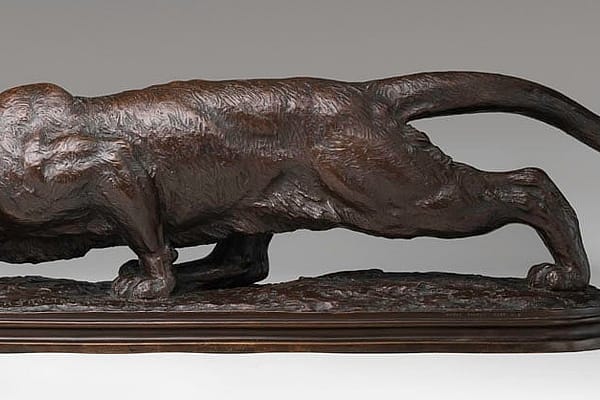
Arab Stallion 2
Arab Stallion (1895)
Bronze Horse; Stallion; Arabian Stallion
Proctor loved horses and was known as an accomplished horseman. Though never a cowboy himself, he explored this equestrian theme throughout his professional life. His first and last sculptures drew on the theme: his Buckaroo of 1915 created a sensation among art and western aficionados alike, and his heroic-sized Broncho Buster was his first human-themed bronze monument ever. He initially came under the wing of his great mentor Augustus Saint-Gaudens because of his facility at rendering horseflesh, and his early career was bolstered by orders from patrons who wanted spectacular, three-dimensional portraits of their favorite mounts.

Arab Stallion (detail — czar crown brand), ca. 1896
Bronze
Private Collection
Proctor’s American Horse of around 1895, for example, portrayed a famous jumper named Ontario (also referred to as Transport) who was jointly owned by the cofounders of the famous Belmont Park racetrack, Samuel S. Howland and August Belmont II. The artist had also used that steed as the model for Saint-Gaudens’s Sherman Monument in New York in the early 1890s. In 1904 he flattered a New Hampshire friend of his, Austin Corbin, by sculpting a likeness of Corbin’s famous Morgan horse, Croydon Prince, in his bronze Morgan Stallion.
But it was a New York lawyer friend known today only by his last name, Dixon, who provided Proctor with his two most dramatic models. One was a horse from Dixon’s Central Park stables that served as the dignified, spirited mount for Proctor’s Indian Warrior of 1898. When, in 1901, Proctor was made an associate member of the National Academy of Design, he was required to submit a diploma piece to the academy’s permanent collection. He chose to send a bronze casting of the Indian Warrior’s horse without the rider, suggesting that he considered it of sufficient merit as an equine sculpture to represent his institutional, artistic legacy (see the Indian Warrior entry in this volume).
Dixon allowed the sculptor to use that horse without charge. However, Dixon had a favorite mount of his own, an Arabian stud, and in 1895, he commissioned Proctor to create a likeness of it. He paid the artist $500.1 The horse’s name is not known, but he was certainly spectacular with his regal bearing and graceful elegance. He had been bred in Czar Nicholas II’s stables in Russia and bore the symbol of imperial power, the czar’s crown, branded on the left side of his neck. [Fig. 1] Proctor proved that his skill was commensurate with the lofty lineage of his model. The resulting bronze became the subject of one of Proctor’s most engaging horse portraits, Arab Stallion. [Fig.2 ]
It is not known which casting Dixon received or where it is today. The piece was copyrighted in 1895 as Arab Stallion. There are nine castings that are known to exist today, including what may be the first. This was produced in Paris, probably in 1896, [Fig. 3] by the E. Gruet Juene Foundry when the artist began his Rinehart Scholarship work.

Arab Stallion (E. Gruet Juene, detail –foundry mark), ca. 1896
Bronze
Private Collection
This was probably the foundry operated by Edmond Gruet, the youngest son of Charles-Antoine Gruet, who worked with Proctor’s hero Antoine-Louis Barye on several of his animalier sculptures.2 Most of the other casts were made as sand casts by Gorham Co. Founders in Providence. They are marked with Gorham’s record indicator, “QRD,” and, in early castings, with an additional boxed inscription, “G/she wolf symbol/C.” [Fig. 4]

Arab Stallion (Gorham, detail — foundry mark), ca. 1915
Bronze
Buffalo Bill Center of the West, Cody, Wyoming. Gift of A. Phimister Proctor Museum with special thanks to Sandy and Sally Church. 18.08.3
A photographic reference in the Proctor Archives indicates that Jno. Williams Foundry of New York cast one or more of these works as well. None of the latter, however, has been found. Proctor was a great admirer of Barye. When the young American sculptor first visited Paris as a student in 1893, he purchased a number of Barye bronzes. He was likely familiar with Barye’s bronze Pure Blood Arab Horse, [Fig. 5] which had first been cast in 1873 and which, despite its slightly less animated pose, may well have inspired Proctor’s Arab Stallion.

Pure Blood Arab Horse, ca. 1880
Bronze, 11 7/16 in. (height)
Private Collection











